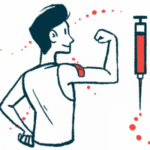Disability after RRMS diagnosis may predict transition to SPMS
Self-reported information about symptoms could shed light on progression
Greater self-reported physical disability within the first years of being diagnosed with relapsing-remitting multiple sclerosis (MS) is associated with a higher likelihood of transitioning to a progressive form of the disease.
The finding comes from a recent analysis of patient-reported data from the U.K. MS Register. Scientists believe the findings indicate that disability levels around the time of an MS diagnosis could predict how a person’s condition might progress.
“These results suggest information provided by people with MS themselves about their physical symptoms, could have the potential to predict how their condition may worsen in the future,” Catherine Godbold, PhD, research and communications manager at the MS Society U.K., said in a press release. “Being able to predict MS progression could help people make more informed decisions about their care and give them more clarity about the future.”
The study, “Patient-reported outcomes in multiple sclerosis: a prospective registry cohort study,” was published in Brain Communications.
Most people with MS are first diagnosed with RRMS, a form of the disease that features periods of new or worsening symptoms, called relapses, followed by periods of partial and complete recovery, or remissions.
In the absence of MS treatments, about half of RRMS patients are estimated to progress to SPMS, where disability accumulates and symptoms get worse even when there are no relapses, within a decade of the onset of the disease.
A tool to track disease progression
As more patients receive treatment early on in the course of their disease, fewer are transitioning to SPMS and those who do are progressing later. Researchers still lack the tools to predict which relapsing MS patients will develop a progressive disease course later, however. Understanding that transition better could help doctors give patients the right treatments and potentially slow down this progression.
The U.K. MS Register has been collecting long-term, real-world data from MS patients in the U.K. since 2011. Patients can complete various patient-reported questionnaires via an internet portal and their healthcare team can input objective clinical data, making it a valuable and cost-effective tool for gaining insights about the disease’s progression.
In the study, researchers looked at data from 15,976 MS patients included in the register from May 2011 to April 2022.
They particularly reviewed responses to two patient-reported questionnaires, the Multiple Sclerosis Impact Scale motor component (MSIS-29) and the Multiple Sclerosis Walking Scale (MSWS-12), to get a sense of patient-reported physical disability. Both are designed to capture the motor element of the Expanded Disability Status Scale (EDSS), the mainstay clinical evaluation of MS disability.
People with progressive forms of MS had higher average scores on both scales — indicating greater disability — than people with RRMS or benign MS both at disease onset and throughout follow-up. Benign MS is defined as having no signs of disease activity for at least 15 years after a first disease attack. Motor and walking function generally got worse over time with all MS subtypes, except benign MS.
“This makes intuitive sense as [benign] individuals have a milder form of multiple sclerosis and experience less, if any, physical disability,” the researchers wrote.
‘Steadily worsening disability’
People with RRMS tended to show gradually and steadily worsening disability, looking similar to benign MS at the onset of their disease, but becoming more similar to progressive MS over time. That’s consistent with the notion that some of them haven’t been diagnosed with SPMS yet, but eventually will be, the researchers said.
On the other hand, those diagnosed with SPMS or primary progressive MS (PPMS) had steadily higher disability levels that plateaued in later years.
Scores on both questionnaires for each disease subtype significantly differed from scores of all other subtypes, with the exception of MSIS-29 scores between benign and RRMS.
The researchers then examined whether scores in these patient-reported measures could help distinguish RRMS patients who transitioned to SPMS from those who didn’t. Physical disability scores were significantly higher among RRMS patients who later transitioned to SPMS over those who always had RRMS, findings showed.
We demonstrate that the more pronounced disability of those who will become progressive is evident early in the natural history of the disease, that is, years before the clinical label is changed.
These differences were observed from disease onset and up to 45 years after diagnosis. In other words, RRMS patients who later transitioned to SPMS reported worse motor and walking disability in the first years and for several years after their RRMS diagnosis compared to patients who hadn’t transitioned.
“We demonstrate that the more pronounced disability of those who will become progressive is evident early in the natural history of the disease, that is, years before the clinical label is changed,” the researchers wrote, noting the findings underscore the value of patient-reported outcomes and online registries to evaluate disease trajectories.
Such measures, “enable us to detect this gap as they provide data at a larger population scale, across longer time spans and at a more affordable cost than traditional cohort or clinical trial studies,” said the researchers, who plan in later studies to investigate whether early changes in mood, sleep, or cognition are also evident in RRMS patients who will later progress to SPMS. “The combination of these findings will allow us to evaluate the potential for assigning individualized progression risk quotients … at the early stage.”







